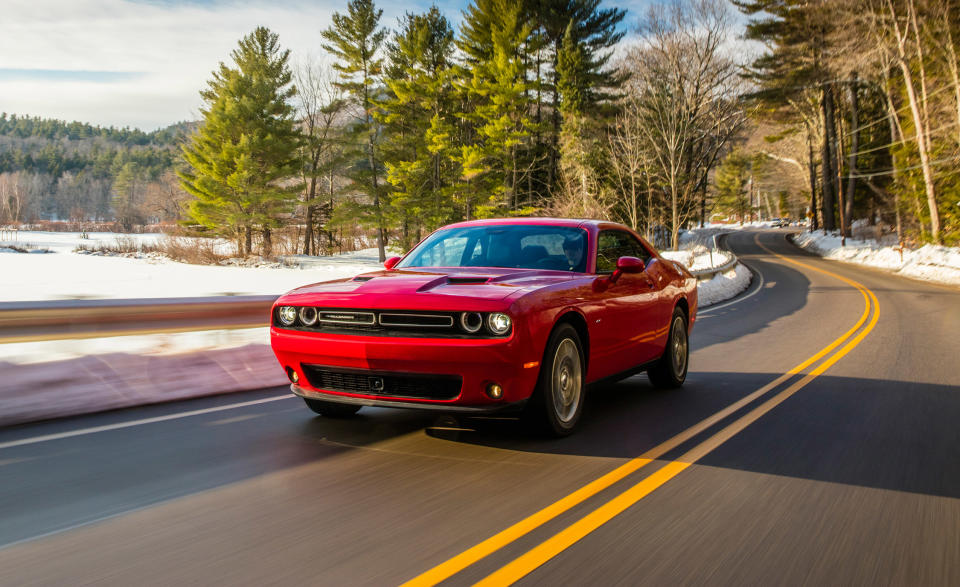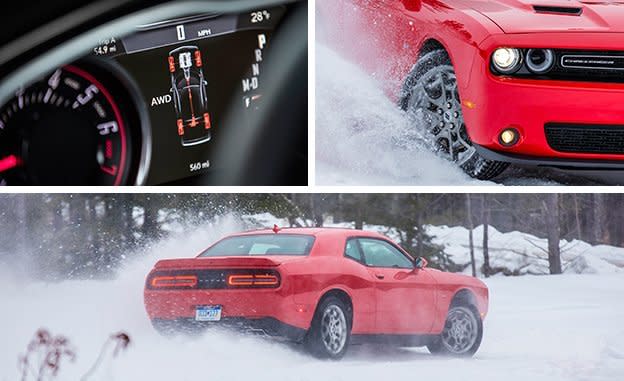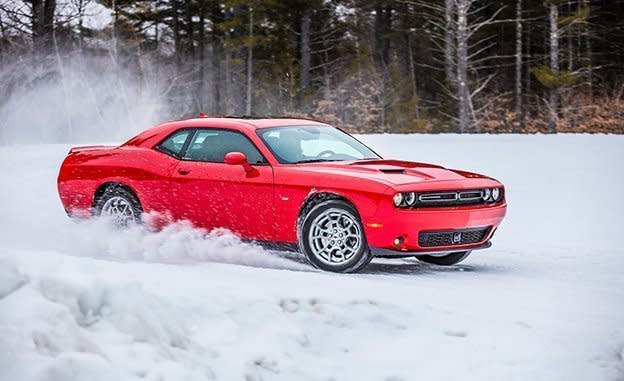2017 Dodge Challenger GT AWD

From the May 2017 issue
An American muscle car without burnouts? What’s next, a Fourth of July without fireworks? Barbecues without beer? Football without repetitive brain trauma? That’s exactly what Dodge is proposing with its all-wheel-drive Challenger GT. It robs any hope of a rear-tire fire, trading old-school juvenile fun for modern all-weather traction. It’s a segment first—and a potentially wise move to rescue sinking muscle-car sales with all-season utility.
To turn a pony into a mountain goat, the Challenger receives the driveline hardware found in its sibling, the Charger SXT AWD. The addition of a driven front axle and accompanying componentry increases the overall mass by 157 pounds, bringing the total to a whopping 4103. At least the modified Charger police-cruiser suspension does a noteworthy job of handling the additional weight. The steering is responsive, and the side-to-side athletics are well mannered even as the all-season tires howl through apexes. Controlling body roll comes with compromise, however, as the overall ride is firm and busy over undulating surfaces. That said, the tall, 55-series tires diminish harsh impacts relative to the 40- and 45-series rubber on higher-spec Challengers.

Calling this Challenger the first all-wheel-drive muscle car may be a bit of a stretch, though, since it’s not all that muscular. Powered by FCA’s familiar 305-hp Pentastar V-6, the steel horse makes it through the quarter-mile in 14.8 seconds. Though launch control is featured in the Uconnect infotainment Performance Pages, it’s a ruse. A 3500-rpm launch can be selected, but the torque converter limits engine speed to 2500 rpm while stationary, creating an uneventful dash from zero to 60 mph in 6.3 seconds. Despite its newfound traction, the acceleration times are actually slower by 0.1 second to 60 and through the quarter-mile when compared with rear-wheel-drive V-6 models, which means the Challenger GT is the slowest of the current generation of Big Three pony cars, even lagging behind the turbocharged four-cylinder versions of the Ford Mustang and Chevrolet Camaro.
Torque is routed solely through an eight-speed automatic transmission; a manual is not available. The all-wheel-drive system, capable of decoupling the front axle to reduce parasitic loss and increase efficiency, favors rear-drive most of the time. When the temperature dips into winter-like readings, or when the computer detects wheelslip, a clutch seamlessly engages the propshaft, sending up to 38 percent of the available torque to the front axle. The activation of sport or manual shifting mode will also lock the system into all-wheel drive. Here in Michigan, where winters sometimes last into spring, we confirmed what the system advertises: all-weather performance. The front tires are eager to provide additional bite in icy conditions, and, if one desires, well-controlled slides can be performed.

Outside, the Challenger’s bulky proportions and retro looks remain unchanged. The GT’s standard 19-inch wheels house front rotors that are one inch larger than those on SXT trims, although any benefit is lost to the all-season rubber. Our GT required 176 feet, 14 more than the last Challenger SXT we tested, to stop from 70 mph.
Starting at $34,490, the GT offers a higher degree of four-season capability than its Ford and Chevy competitors. But selling the soul of the American muscle car to gain cold-weather practicality feels a little like trading glory for comfort. We’d stick with a rear-drive V-8 and swap to winter tires when the frost settles.
Specifications >
VEHICLE TYPE: front-engine, all-wheel-drive, 5-passenger, 2-door coupe
PRICE AS TESTED: $39,465 (base price: $34,490)
ENGINE TYPE: DOHC 24-valve V-6, aluminum block and heads, port fuel injection
Displacement: 220 cu in, 3605 cc
Power: 305 hp @ 6350 rpm
Torque: 268 lb-ft @ 4800 rpm
TRANSMISSION: 8-speed automatic with manual shifting mode
DIMENSIONS:
Wheelbase: 116.2 in
Length: 197.9 in
Width: 75.7 in Height: 57.5 in
Passenger volume: 94 cu ft
Trunk volume: 16 cu ft
Curb weight: 4103 lb
C/D TEST RESULTS:
Zero to 60 mph: 6.3 sec
Zero to 100 mph: 16.3 sec
Zero to 130 mph: 35.4 sec
Rolling start, 5–60 mph: 6.7 sec
Top gear, 30–50 mph: 3.5 sec
Top gear, 50–70 mph: 5.1 sec
Standing ¼-mile: 14.8 sec @ 95 mph
Top speed (governor limited): 131 mph
Braking, 70–0 mph: 176 ft
Roadholding, 300-ft-dia skidpad: 0.86 g
FUEL ECONOMY:
EPA combined/city/hwy: 21/18/27 mpg
C/D observed: 20 mpg

 Yahoo Autos
Yahoo Autos 